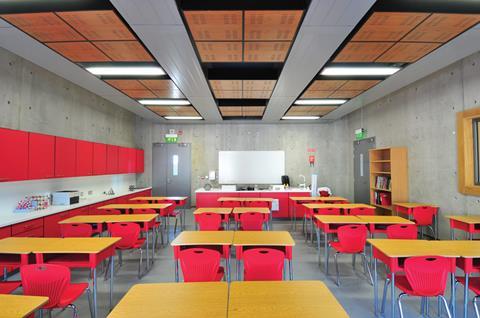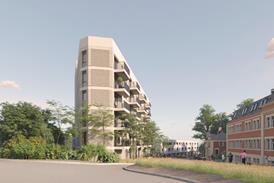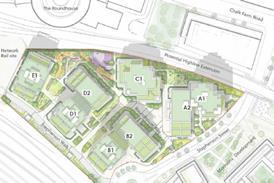A variety of passive and active acoustic strategies are employed in educational buildings to control sound levels and reverberation and provide an optimal teaching environment. This CPD module is sponsored by Armstrong Ceilings
How to take this module
To take this module read the technical article below and click through to a multiple-choice questionnaire, once taken you will receive your results and if you successfully pass you will be issued automatically with a certificate to print for your records.
Acoustic performance is an essential part of providing a suitable learning environment. If teaching takes place in rooms where the teacher’s voice reverberates too much, or where external noise makes it difficult to hear, students’ academic performance is likely to suffer. School buildings must also adapt to changing needs — computers, the web and audio-visual aids such as interactive whiteboards are all altering the acoustic requirements of classrooms.
Suspended ceilings are the largest open and mostly unaltered space within a classroom. This is the perfect space for the acoustical treatments necessary to enhance the learning environment. Suspended ceilings can provide suitable passive acoustics, where the tile materials either absorb or reduce sound. But they are also the most suitable place for the integration and seamless mounting of active acoustic treatments, such as speakers for soundfield systems.
This CPD module will examine the principles behind the different passive and active acoustic strategies that can be incorporated into suspended ceilings to create the best possible learning environment. But first, it will outline the regulatory framework that underpins acoustic performance in schools.

Regulations governing acoustics in schools
The Building Regulation in England and Wales for acoustics (Part E) was revised in 2003 to include a new section — E4. This specified that the acoustic conditions in schools must be considered as part of the Building Regulations approval process.
It refers to Building Bulletin 93 (BB93) as the key guidance for meeting the requirements of section E4. BB93 sets out performance standards with the overall objective of the provision of acoustic conditions that both facilitate clear communication of speech between a teacher and students, or between students, and do not interfere with study activities.
BB93 sets a number of performance standards and guidelines regarding different aspects of the acoustic performance of schools. These include:
- Indoor ambient noise level
This is dependent on a number of factors including external noise such as traffic, service noise, the noise level in the room, and so on. BB93 sets a number of upper limits for indoor ambient noise levels in different types of room — for example, a general teaching area in a secondary school has a limit of 35dB over 30 minutes. - Airborne sound insulation between spaces (including corridors and stairwells)
Again, BB93 sets a number of performance standards depending on the type of activity in the source room and the noise tolerance in the receiving room. - Impact sound insulation between spaces and floors
BB93 stipulates that slab-to-slab walls are the preferred solution. Rain noise on roofing also needs to be considered, particularly as new construction techniques within the school sector can allow unwanted rain noise to transmit through the roof and void space into a classroom. Tolerance levels are set depending on the activity in the source and receiving rooms. - Reverberation in teaching and study spaces
If there is too much reverberation in a room, it can make speech unintelligible. BB93 states that the reverberation time (RT) should be calculated for unfurnished rooms. For primary school classrooms, the RT should be <0.6 seconds; for secondary school classrooms <0.8 seconds; and for rooms specifically designed for hearing impaired students <0.4 seconds. No minimum RT is specified, although many acousticians recommend a minimum of 0.4 seconds to prevent the space from becoming too acoustically dead (especially as furnishings and children will reduce further the RT). - Sound absorption in corridors, entrance halls and stairwells
BB93 suggests the ceiling is the only practical place to install the required absorptive material (see Passive Acoustics section for the required absorption levels). - Speech intelligibility in open-plan spaces
These are acoustically complex spaces and have multiple speaker and receiver positions, so require speech transmission index (STI) computer prediction models based on an activity plan and predicted noise levels. The STI scale is measured from 0.0-1.0. An STI of 0.60-0.74 indicates good intelligibility; 0.75-1.00 indicates excellent intelligibility. The minimum required STI is 0.60.

Passive acoustics
Passive acoustic measures are those that use materials and finishes to interact with, and control, sound. These perform one of two main functions. First, the use of sound-absorbing materials limits RT. Second, the use of good sound-attenuating materials and details blocks transmission between rooms. The best learning environment is one that creates a balance between absorbing internal sound and blocking external noise (this may involve the use of active acoustics as well).
Sound absorption
Absorption is rated either under the US NRC method or the European-weighted alpha w method on a scale from 0.0 (100% reflection) to 1.0 (100% absorption). For example, a Class C absorber has a rating of 0.60-0.75, and a Class D absorber has a rating of 0.30-0.55.
Classrooms generally require a Class C or D absorber; corridors and reception areas require a Class C absorber; larger areas such as halls may require slightly higher absorption; and music rooms require less absorption. In corridors and stairwells, Part E4 states that a Class C absorber (or better) should be used over 100% of the floor area, or that a calculation is completed to determine the total amount of absorption required. For stairwells, it is stated that a Class D absorber (or better) should be used over 100% of the floor area, or a Class C absorber over 50% of the floor area.
Sound reduction
If background noise from an external noise source is too loud, a teacher’s voice may be drowned out, meaning that students cannot hear and will not learn effectively.
A concept used to help provide good listening conditions is signal-to-noise ratio: generally, a difference of 10dB is desired between the signal (the teacher’s voice) and the noise (background or intruding level).
Some materials can help to reduce noise transmission, but they tend to be thick and heavy. The Mass Law states that there is a linear relationship between mass and sound reduction — generally speaking, by doubling the mass, noise transmission is reduced by 5dB.
Absorption vs reduction
Sound-reducing materials are therefore not generally the same ones that absorb sound. Whereas sound-absorbing products tend to be soft and light, or thin and rigid with an airspace behind, sound-reducing materials need greater mass. This is highlighted in the performance of different acoustic materials:
- A product with low sound-absorption performance will usually have a reflective surface, preventing porous sound absorption. However, they generally provide good sound reduction. Examples include plain-metal tiles or some plain reflective mineral-fibre tiles.
- A product with medium sound absorption performance will usually have a porous surface, allowing sound absorption within the mineral fibre core. They also tend to provide good sound reduction. Examples include standard mineral fibre tiles or metal tiles with mineral fibre infill.
- A product with high sound-absorption performance will usually have a porous surface, allowing sound absorption within a very lightweight soft fibre core. However, they only provide very low levels of sound reduction. Examples include soft fibre tiles and metal tiles with lightweight acoustic pads.
A passive acoustic strategy must therefore balance the appropriate levels of absorption and reduction. It may also need to be supplemented by active acoustics.
Types of absorber
Absorptive materials are usually installed in ceilings as they provide the largest unobstructed area and are evenly distributed in relation to all students. There are two main types of absorber — porous and panel — and many ceiling tile products provide a combination of the two.
Porous absorbers are those where the sound energy must be able to penetrate the surface of the tile to reach the absorbing core material. They provide high levels of sound absorption and perform better at higher frequencies.
Panel absorbers are thin and rigid with an air gap behind them. They provide lower levels of sound absorption and at a narrower band of lower frequencies.
Active acoustics
Active acoustic measures include public address systems, sound masking (white noise played through speakers to mask intrusive noise) and, most commonly in classrooms, soundfield systems.
Soundfield systems
A soundfield, or voice-reinforcement, system is a technology first introduced in the US in the 1970s. It increases the volume of direct sound, particularly for more distant listeners, while keeping the sound as natural as possible — it does not overpower the direct signal from the teachers. It is an inclusive technology which is an extension of, but doesn’t necessarily replace, personal hearing-aid systems.
NXT flat speakers spread the sound, avoiding the spotlight effect of standard cone speakers. BB93 states that the best speaker position for even coverage across a room is in the ceiling. Integrated flat speakers can replace a full ceiling tile, preventing the need to cut holes in tiles, and are available in finishes that match popular ceiling tiles, creating a less cluttered aesthetic. As they also spread the sound over a wider angle than cone speakers, fewer speakers tend to be needed.
BB93 also states that infrared is a better transmission system than VHF/UHF radio as it is wideband, so confined to one room; can be used with personal hearing aids using a neck loop; and can be used in different rooms without retuning.
A soundfield system can be linked in to additional ICT or audio-visual equipment such as TVs, DVD players, computers and interactive whiteboards.
To take this module read the technical article and click through to a multiple-choice questionnaire, once taken you will receive your results and if you successfully pass you will be issued automatically with a certificate to print for your records.
Company name: Armstrong Ceilings
Website: www.armstrong.co.uk
The old business maxim Caveat emptor - “Let the buyer beware” - was turned on its head by Armstrong’s founder. Five simple words… a profound belief. Down through the years, the company has continued to prove itself worthy of that customer faith - through the respect shown to individuals in all its dealings; through the high moral and ethical standards consistently maintained; and in the integrity, reliability and forthrightness reflected in all its relationships.
















No comments yet